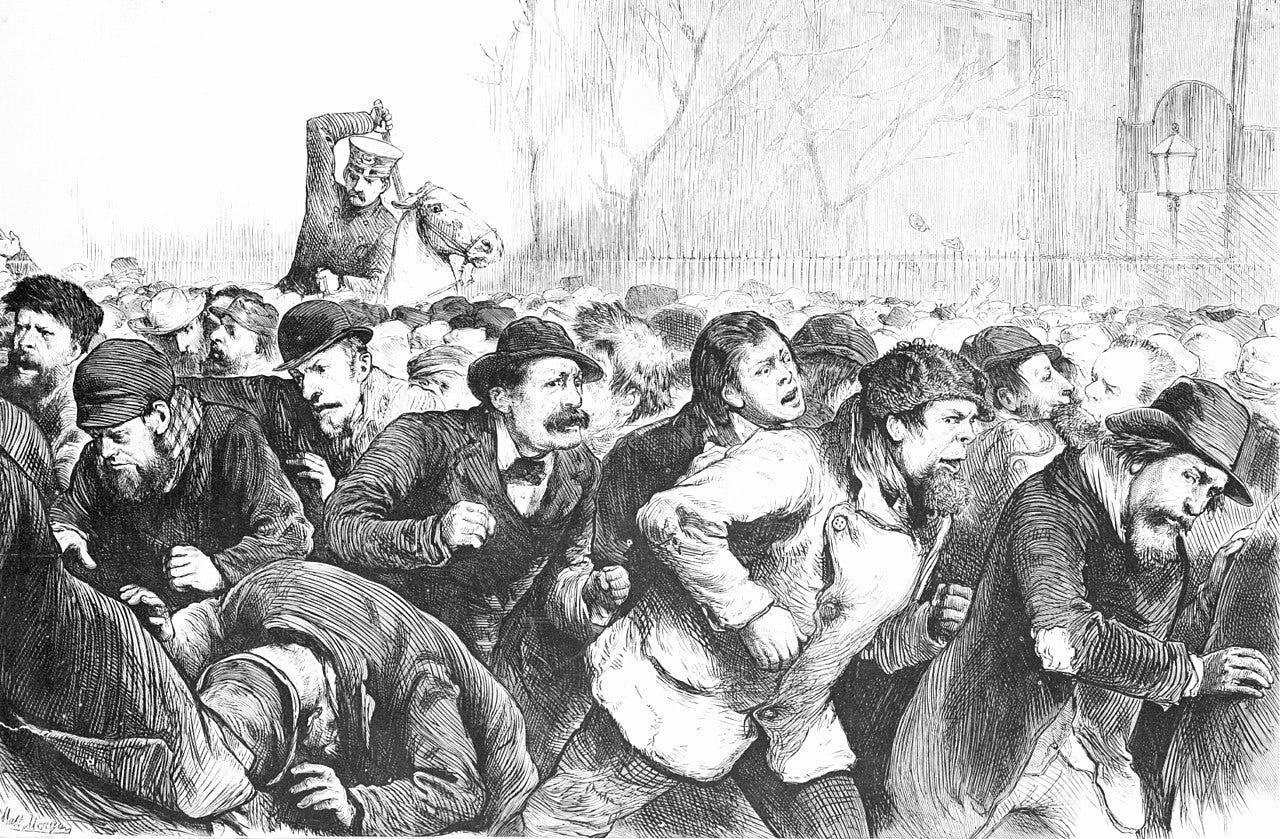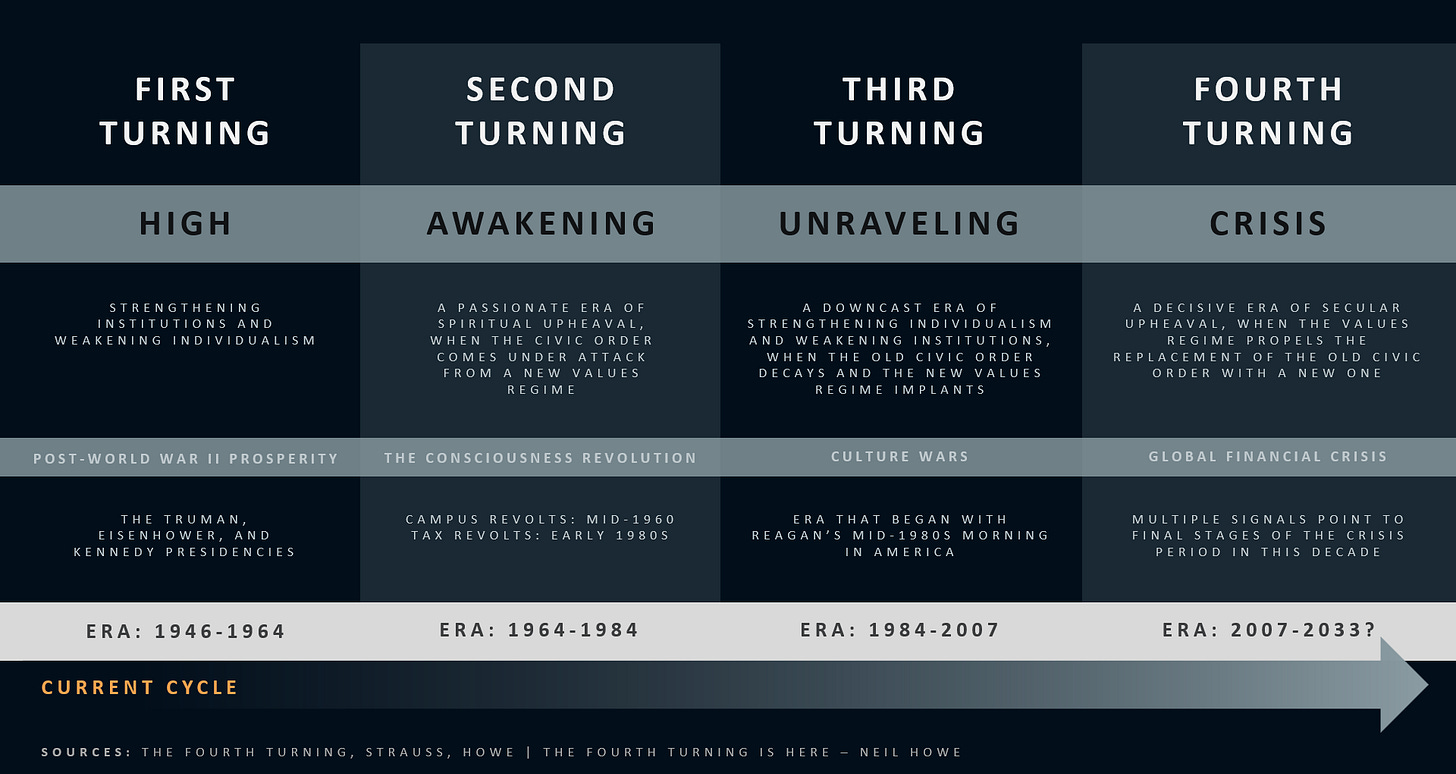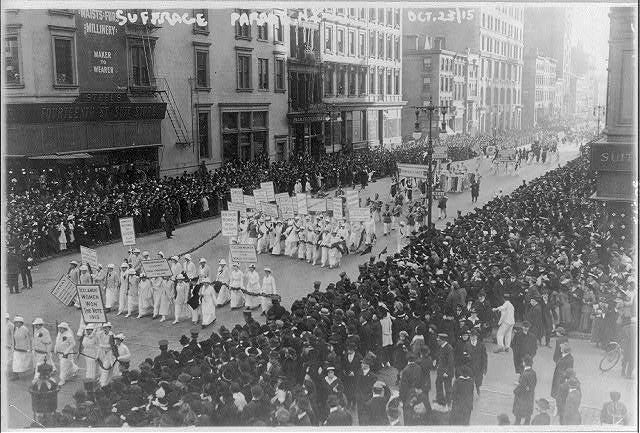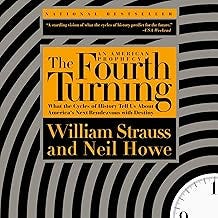When the Old-World Dies
What we believe will shape what survives.
Twenty-four years ago, two planes tore through steel and sky, and nothing has felt stable since.
September 11, 2001 was supposed to be the shock that united us. But instead, it kicked off a slow-motion implosion. Wars followed. Surveillance bloomed. And in 2025, trust has collapsed. We’re no longer arguing about what broke, we’re wondering what’s coming next.
Because something always comes next. Every old order eventually crumbles. What matters is what will fill the vacuum. The mistake is assuming it's chaos. It’s not. Chaos is short-lived. The real threat is the story that steps in after the dust settles. The myth, the new center of gravity.

We’re living through one of those moments right now. The old world is dying. A new one is rising. But we haven't decided yet what it will be.
After 9/11, we tried to fight fear with strength. We invaded Iraq. We turned airports into security theaters. We built an empire of drones, data, and black sites. But it didn’t make us feel safer. It just made us forget what the old order even stood for.
Freedom? Justice? Unity?
By the 2010s, those words rang hollow. The banks collapsed. Washington got richer. The middle class shrank. And into that growing vacuum came something ancient: tribalism.
The Fourth Turning predicted this.
Strauss and Howe argued that every 80-100 years, societies go through four generational “seasons.” The final one, the Crisis, is winter. A breakdown. A reckoning. It destroys what no longer works and demands something new to take its place. They said America’s next crisis would begin around 2005 and crescendo in the 2020s. They were right.
Look at where we are.
The post-9/11 world order has collapsed. Trust in institutions, e.g. Congress, media, universities, is at historic lows. The war in Ukraine drags on. The Middle East is boiling again. BRICS nations are building a new economic bloc. China’s sphere is expanding. The U.S. is divided, uncertain, and drifting.
At home, people talk more about AI models and dopamine loops than God or country. Public schools are battlegrounds. Urban cores are hollowing. Crime is rising. Tech billionaires live like feudal lords in space and underground bunkers.
This is what a vacuum looks like.
But nature and history hate vacuums.
And so, the void is being filled. Not just with power, but with stories.
Some people dream of restoring an imagined past. Others want to accelerate into a hyper-technological future. Still others seek refuge in ancient faiths, homesteads, and offline communities. Everyone is looking for an anchor.
Because what fills the vacuum when an old order breaks down isn’t chaos. It’s conviction. In 2001, Americans still believed in shared truths. Today, we believe in algorithms.
After the Capitol riot in 2021 and the AI-driven protests of 2024, it’s clear that mass movements don’t need leaders anymore. They need bandwidth. Meaning is now generated virally, not institutionally.
And that’s dangerous.
Because meaning without wisdom becomes zealotry.
We’ve been here before.
When Rome’s republic fell, Caesar offered order.
When Weimar collapsed, Hitler offered glory.
When the Qing dynasty crumbled, Mao offered revolution.
They didn’t rise because people loved tyranny. They rose because people were tired of uncertainty. Exhausted by corruption. Starved for something real even if it cost them everything.
And now?
We’re not far from our own decision point.
2025 is a crossroads. America is on edge. Europe is fractured. China is preparing something. AI is accelerating faster than regulation. People no longer agree on what a “man” or “woman” is, let alone what a nation is for.
The myth of progress has cracked. The promise of equality has warped. The tech utopians lied. The postwar order is a memory.
So, the question isn’t “What’s broken?” It’s: What are we going to believe in now?
Will we double down on tribalism?
Will we worship the machine?
Will we burn it all down and start over?
Or will we remember that meaning isn’t just about passion, it’s about sacrifice?
Some movements are already offering their answers.
Populists promise strength, borders, and belonging.
Technocrats promise efficiency and immortality.
Religious revivals promise salvation in a world gone mad.
Eco-ascetics promise purification through collapse.
Each of them is growing. Each of them is recruiting. And none of them is asking for moderation.
Because moderation doesn’t fill a vacuum. Fire does.
Strauss and Howe warned us: in the Fourth Turning, the center does not hold. What rises is something new and it’s usually born in conflict.
They pointed to past crises:
The American Revolution (1770s–1790s)
The Civil War (1860s)
The Great Depression and WWII (1930s–1950s)
Each shattered an old world. Each forged a new one. And each was followed by a “High” — an era of renewal, purpose, and rebuilding. But only after deep suffering. The question now is: What kind of suffering are we walking into? It may not look like war. At least not yet.
It may look like segregated economies, where red and blue America don’t just vote differently, they shop, learn, and bank differently. It may look like AI-authoritarianism, where your digital footprint defines your rights. It may look like religious warfare, not with swords, but with laws, platforms, and institutions. Or it may look like a Great Silence, millions withdrawing from a system they no longer believe in.
There’s still time to shape what fills the vacuum. But the clock is ticking. Because when people feel unmoored, they cling to tribe, to myth, to anything that tells them they matter. And if no one gives them a story worth living for, someone will give them one worth killing for.
That’s what history teaches us. That’s what the last 24 years have shown. We built the post-9/11 world on sand. We trusted that economic growth, digital connection, and cultural tolerance would be enough. They weren’t.
Now the storm has arrived. And the world is watching to see what we build next.
So, what fills the vacuum when an old order breaks down?
A story. Always a story.
The only question is: will we write it with courage and clarity or let fear write it for us?
What Has Filled the Vacuum in the Past?
Five historical case studies you won’t find in most textbooks because they’re too uncomfortable, too instructive, and too real.
1. The Fall of the Roman Republic → Caesar’s Personal Empire
Vacuum Filled By: Charismatic dictatorship
Timeframe: 49–27 BC
Trigger: Elite corruption, civil wars, collapse of Senate credibility
Lesson: When institutions rot from within and partisanship paralyzes reform, the people turn to a man instead of a system. Caesar didn’t just seize power, he gave Romans a new meaning: Rome as an empire of destiny, not just a city of laws. His rise didn’t fix the Republic. It ended it. Permanently.
2. Weimar Germany → National Socialism
Vacuum Filled By: Myth-driven totalitarianism
Timeframe: 1919–1933
Trigger: Postwar humiliation, inflation, identity collapse
Lesson: Liberalism collapsed not through sudden violence but rather eroded slowly and quietly. Germans craved order, dignity, and a shared myth. Hitler gave them all three through blood, soil, and scapegoats. The old Weimar elite underestimated how deep the hunger for meaning was. Millions surrendered reason for myth.
3. French Monarchy Collapse → Terror and Empire
Vacuum Filled By: Revolutionary ideology, then military dictatorship
Timeframe: 1789–1799
Trigger: Bankruptcy, food shortage, elite detachment
Lesson: The monarchy fell because it couldn’t reform. The revolution devoured itself because it couldn’t govern. What finally filled the vacuum? Napoleon, a man who offered national pride, institutional discipline, and glory. The people wanted bread. He gave them conquest.
4. The Soviet Union Collapse → Oligarchy and Strongman Rule
Vacuum Filled By: Authoritarian restoration
Timeframe: 1991–1999
Trigger: Economic collapse, loss of identity, sudden freedom
Lesson: Gorbachev opened the system. Yeltsin lost control of it. And Putin re-forged it. He didn’t rebuild the USSR. He rebuilt its spine… power and pride. In the chaos of the 90s, Russians learned that democracy without dignity is not liberation, it’s humiliation.
5. The Bronze Age Collapse → Local Kingdoms and Warrior-Priest Orders
Vacuum Filled By: Tribal theocracies, smaller warlord-run states
Timeframe: 1200–1000 BC
Trigger: Climate stress, trade collapse, foreign invasions
Lesson:
When entire empires fell (Mycenae, Hittites, Ugarit), what replaced them wasn’t more complexity, it was simplicity. Warrior-chiefs. Local cults. Walls and blades. People didn’t need cities; they needed protection and prophecy. Israel rose from this chaos. So did Phoenicia. Collapse isn’t the end; it’s the soil for something radically different.







If we choose out of fear, we'll repeat patterns. If we choose out of courage, well open portals to something new.
The old formalism dies because it does not change, because it does not see a reason to change. “If it ain’t broke, don’t fix it.“ Instead, it becomes brittle, reactionary and vulnerable to collapse.
Our pastoral forebears proclaimed that there was a season for everything. But then the electric light banished the night, the train and the auto banished distance, the plane and the radio banished time, and now, month by month, it becomes more clear that our accelerating technological advance is on the verge of obviating classical social evolution.
Historians will describe forces opposing the new techno-reality as resurgent Luddism.